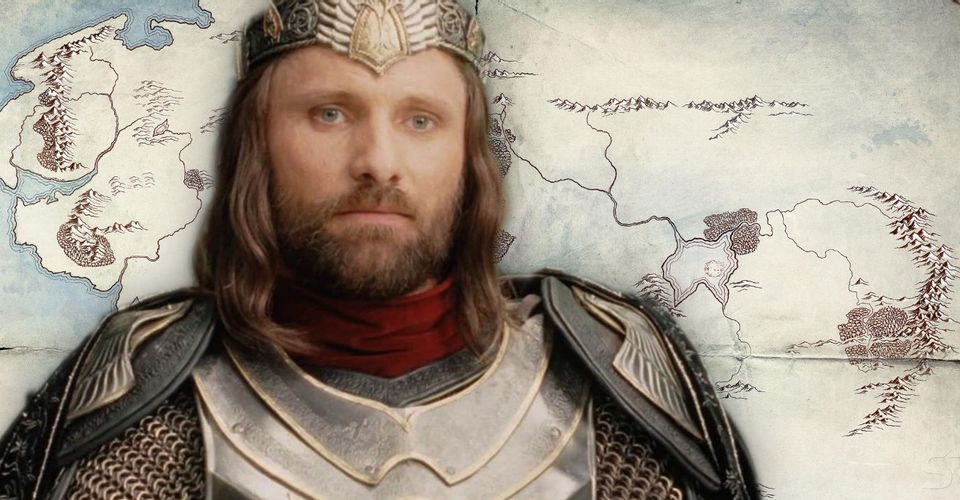Everything We Know About Middle-earth After Lord of the Rings

A lot changed in Middle-earth after The Lord of the Rings – both in the books and the films. The final film in the trilogy, The Return of the King, had a big impact on the future Middle-earth and its most important characters. After stealing the One Ring and fighting with Frodo (Elijah Wood), Gollum (Andy Serkis) plunged into the fiery pits, and the One Ring was finally destroyed. The destruction of the Ring triggered the death of Sauron, who could not exist without the One Ring’s power. Mordor collapsed, and the war was finally over.
Sauron’s defeat allowed for a happy ending for the surviving members of the Fellowship of the Ring as they moved on with their lives. Frodo and Sam (Sean Astin) returned to the Shire at last, and Sam started a family. Frodo, however, wasn’t content with his life in the Shire, due in part to injuries he sustained in The Lord of the Rings; in the end, Frodo sailed away for the Undying Lands. Meanwhile, Aragorn (Viggo Mortensen) was crowned King of Gondor. He married the Elf, Arwen (Liv Tyler), who willingly gave up her Elven immortality in order to share a life with Aragorn. Aragorn lived a long, full life with Arwen, and passed away at the age of 210.
Related: Lord of the Rings: Saruman’s Movie Death Explained (& Why It Was Cut)
Most of these events took place in an era that’s known as the Third Age. The timeline of Middle-earth is broken up into several long eras, and the Third Age is just one of them. The Second Age is the focus of Amazon’s Lord of the Rings TV series. The Third Age, on the other hand, which lasted for a period of 3021 years, is the setting for both The Hobbit and The Lord of the Rings trilogies. Shortly after the conclusion of The Return of the King, the Fourth Age kicked off. Here’s what the end of the Third Age and the dawn of the Fourth Age had in store for Middle-earth.
Aragorn Created the Reunited Kingdom

Located in the north, Arnor was a prominent kingdom in the Second Age of Middle-earth. Populated by Elves, Hobbits, and Men, Arnor thrived for centuries but in the early part of the Third Age, Arnor was no longer such a prosperous place. Political unrest and deceit divided the kingdom into three, smaller kingdoms, and over time civil war brought them to their knees. There were attempts at reunification. For a time, Gondor and Arnor were one kingdom, but this didn’t last. After its fall, what was left of the people of Arnor moved on to other regions.
One of the kings of Arnor’s descendants is Aragorn. This meant that Aragorn, who was already the King of Gondor, was also entitled to the throne of Arnor. As a result, Aragorn rebuilt Arnor and became its 26th king. This allowed Aragorn to take the position of High King of Arnor and Gondor, a title that hadn’t been held since Isildur in the Second Age. After centuries of being apart, Aragorn mended the split between Arnor and Gondor and created the Reunited Kingdom. Under Aragorn’s control, the Reunited Kingdom became the most dominant force in the northwest region of Middle-earth. During this time, the Reunited Kingdom set out to retake all of the lands that was previously occupied by Arnor and Gondor. Only certain territories were left alone as the Reunited Kingdom fought to take back what once belonged to them.
The Fourth Age & The Dominion of Men Began

The Elves were the most prevalent race in the First and Second Ages of Middle-earth. This began to change in the Third Age, when the power of the Elves began to wane. In the beginning of the Third Age, the Elves started to leave for Valinor, though many of them remained in various regions of Middle-earth. What was next for the Elves and the fate of Middle-earth was teased by Gandalf at the end of The Return of the King when Gandalf said, “For the time comes of the Dominion of Men, and the Elder Kindred should fade or depart.”
Gandalf’s prediction was proven correct when the remaining Elves left the Middle-earth for the Undying Lands when the Three Rings lost their power as a result of Sauron’s defeat. The departure of the Elves ushered in the dawn of the Fourth Age, which is characterized by the Dominion of Men. Also, the Dwarves began to die off in the Fourth Age, since women only made up a third of their population, and Dwarven females often chose not to marry. So over time, the Dwarves’ contributions to the world were forgotten, leaving humanity the most important race remaining on the face of Middle-earth.
The Shire Became A Sanctuary For The Hobbits

In The Hobbit and The Lord of the Rings, the Shire is the homeland for the Hobbits and a region located in the northwest portion of Middle-earth. The Shire was famously visited by Gandalf and a company of Dwarves in The Hobbit, and again by Gandalf in Lord of the Rings. While the Shire is only occupied by Hobbits, it has seen its fair share of visitors over the centuries. Both Elves and Dwarves have been known to pass through the Shire on occasion. While the Fellowship was off on their adventure, a group of Men called the Ruffians became a threat to the Shire and the Hobbits’ way of life. The Ruffians were dealt with once Frodo and the others returned home.
Things changed for the Shire-folk when Aragorn – known by the name “King Elisaar” in the Fourth Age – formed the Reunited Kingdom. The lands he gained as the High King gave him some level of control over the Shire’s fate. Knowing that people like the Ruffians would always be a problem for the Shire, he declared that the Shire was a sanctuary for the Hobbits that should never be visited by Men, including himself. Aragorn’s intentions for banning Men from the Shire was to ensure that the Hobbits could live peacefully without intervention from outsiders.
About The Author

















